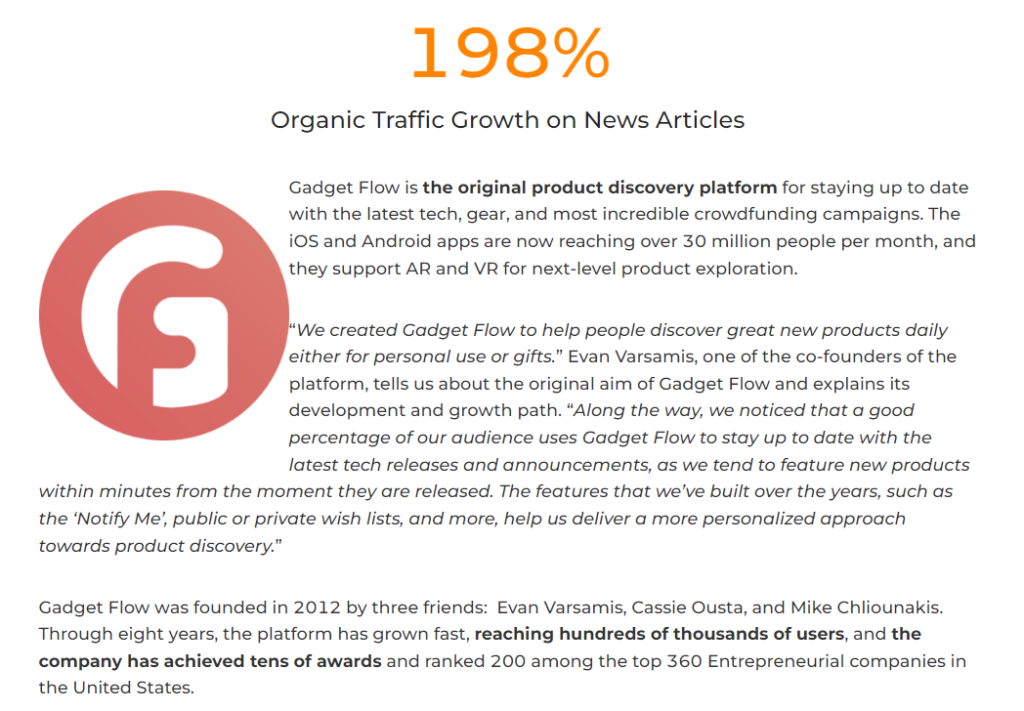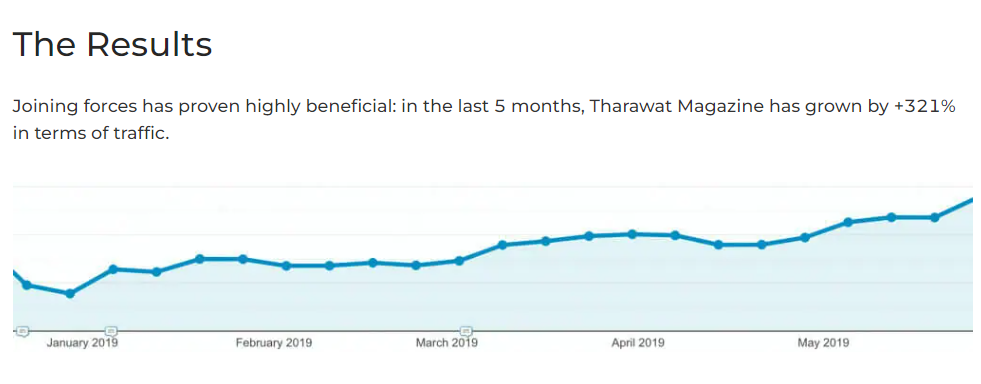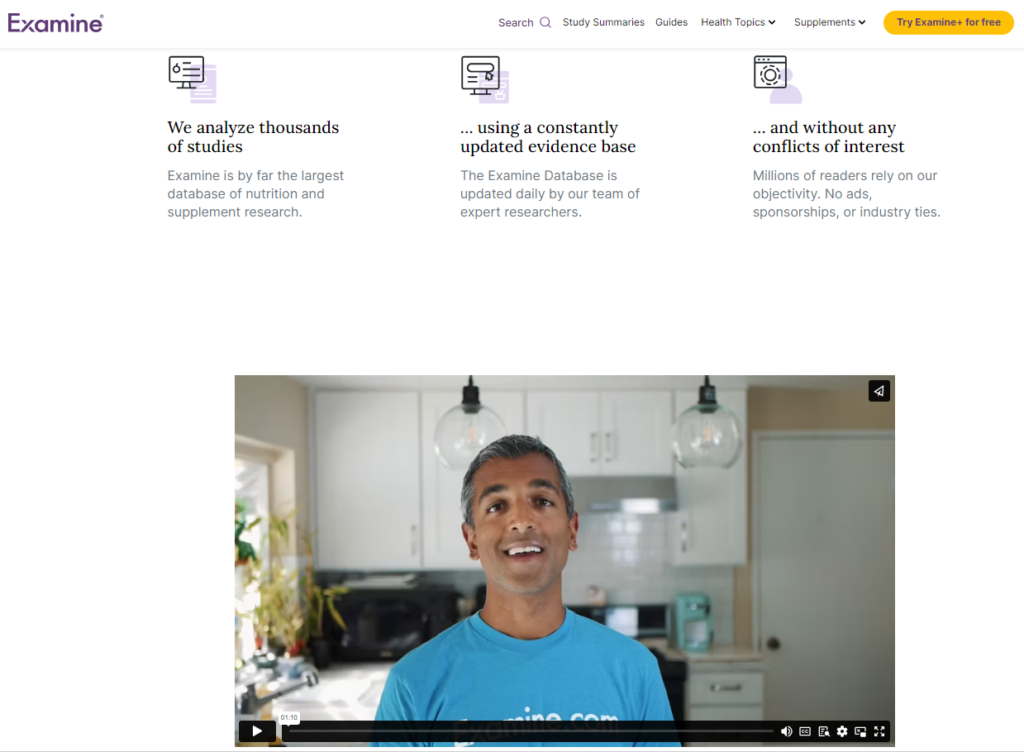When it comes to getting noticed in today’s crowded online arena, your business needs to find strategic ways to make a breakthrough.
These breakthroughs rely heavily on your content, and for that content to be found by your targeted audience, you need an optimized SEO strategy.
Not only will your improved SEO strategy raise your visibility online, but it will also lead to higher possibilities of converting website traffic to potential customers.
So, where can you learn how to improve your strategy and get ahead?
Start with real-world examples, or SEO case studies, which can provide you with access to the best practices already proving successful online.
Keep reading to learn more about this topic.
- Why SEO Case Studies?
- 1. Gadget Flow
- 2. Backlinko
- 3. Gotch SEO
- 4. Windows Report
- 5. Tharawat Magazine
- 6. Robbie Richards
- 7. Freeyork
- 8. Examine.com
- Bonus: How To Write an SEO Case Study
- Wrap Up: Successful SEO Case Studies are a Valuable and Time-Saving Resource
Why SEO Case Studies?
SEO case studies present the various ways you can increase performance on search engines. By studying the key findings for each, you can then apply what you find to your own strategy.
Also, case studies give you a unique opportunity to discover things in a practical way, providing examples and results you can easily relate to, making them a valuable information resource.
The benefits of utilizing the best SEO techniques are many, so why not learn from those already in the mix?
Here are seven success stories to learn from.
1. Gadget Flow
Gadget Flow is a product discovery platform that keeps readers informed on the latest tech and gear out there and also stays on top of unique crowdfunding campaigns.
When the business started, they had little to no competition, but as the internet grew, they realized they needed to find a way to increase organic traffic and boost visibility on search engines.
So, they began to look for innovative solutions and an SEO strategy that would accomplish these goals.
Their focus soon centered on content relevancy.
Gadget Flow wanted to provide readers with the most relevant content, so they stay longer on their site.
The resulting goal, then, became to provide relevant, high-quality content to customers at every level and topic and become the trusted resource customers return to again and again.
With the help of the SEO tool WordLift, Gadget Flow devised a knowledge graph to implement and guide a site-wide content model and enhance its overall SEO.
As part of this growth strategy, structured data was created and added to content, including reviews, blog posts, products, and even videos.
With this new, improved focus on relevant content, Gadget Flow was able to grow organic traffic:
- by 185% for clicks on video content;
- by 198% for news articles (within three months’ time).
In addition, the reviews traffic increased, gaining 100% in clicks.
Bottom line? By providing high-quality content online for your targeted audience, you can attract more traffic and qualified leads and rank higher on search engine result pages (SERPs).
2. Backlinko
Backlinko, a blog created by Brian Dean, is one of the most popular resources to learn about SEO techniques.
Yet, Dean needed to find ways to boost his own visibility in search engine rankings and raise organic traffic to his site.
As a result, his strategy, which he labels “Skyscraper Technique 2.0,” worked, resulting in an increase in organic traffic to his website pages by 652% in just seven days!
Here are the steps he took to reach such an increase.
Determine user intent
To determine the types of information consumers are searching for and user intent, start by thoroughly analyzing the first page of the search results for a specific keyword. These can provide valuable insight. Next, examine each keyword closely.
Satisfy that user intent
Adjust your content marketing strategy and apply this gained knowledge to brand new posts you are planning or by improving existing pieces of content. Cover every aspect of your content, from changing to a favored format to covering more subtopics.
Optimize User Experience (UX) signals
Find ways to optimize your content to minimize bounce rate, increase dwell time, and improve organic CTR. Backlinko’s strategy to accomplish all these and grow his audience included:
- Adding embedded videos, which can keep visitors on a website longer.
- Inserting a Table of Contents to help the reader as well as boost organic CTR.
- Creating short introductions of 5-8 sentences for content.
- Using subheadings (H2 and H3) to break up content.
- Providing numerous examples within the content.
3. Gotch SEO
Nathan Gotch owns Gotch SEO and believes that squeeze pages, content designed to convince readers to give you their contact information, are essential to building your email list and business overall.
The question, however, became how to create a highly-performing squeeze page.
So, Gotch got to work and devised a nine-step process for creating a squeeze page that will provide a 74.5% conversion rate!
That process includes the following.
- First, provide valuable content to build trust and rapport, then send those visitors to your squeeze page.
- Offer some type of lead magnet on the squeeze page.
- Keep your squeeze page highly focused and simple.
- Utilize benefit-driven headlines to attract interest.
- Design the page to be free of unnecessary distractions.
- Include minimal fields for collecting information.
- Provide clear directions.
- Add a distinctive call-to-action (CTA) and make it stand out.
- Include trust signals, including your brand logo, disclaimers, and also meet GDP compliance.
4. Windows Report
Founded in 2012, the UK-based independent online publication Windows Report focuses on contextualizing the Microsoft Windows platform along with other related services and products.
When their organic traffic stalled and remained this way for a long time, they knew they had to do something.
No longer focusing on just the traditional SEO improvements, they looked for other available options to add to their digital marketing strategy.
The solutions they came up with included:
- Building a linked graph on data.windowsreport.com for the magazine.
- Redesigning the way their content is organized utilizing the “entity-based content model.”
What were the results? Windows Report gained over one million new organic users every month.
5. Tharawat Magazine
Tharawat Magazine is one of the world’s premier publications focusing on family-owned businesses, providing inspiration and guidance to all.
With over a thousand articles published and more than a decade in the industry, the magazine soon began thinking about ways to improve its SEO strategy.
More specifically, they desired to incorporate an SEO approach into the editorial workflow of Tharawat Magazine as a way to increase organic traffic.
With the help of a marketing consultant, it was quickly determined that the magazine had accumulated a wealth of content, but that content was being underutilized.
As a solution, a clean-up of all content occurred, and over 1,000 articles were structured.
The goal of these measures? To increase visibility by better utilizing the content they already had.
As a result, within five months, Tharawat experienced accelerated returns, with an impressive +321% in traffic.
The reasoning behind these returns involved the acknowledgment that the editorial team’s gained understanding and ability to read traffic data helped facilitate a more SEO-friendly editorial plan.
6. Robbie Richards
Robbie Richards is a marketing expert with a popular website.
When one of his readers became an SEO success story, he had him share a case study to show others how it was accomplished.
UAV Coach is a fast-growing business specializing in commercial drones. The founder, Alan Pearlman, found that he needed to generate more recurring traffic and build leads.
The solution involved an SEO strategy built around evergreen content for long-term exposure, authority positioning, lead generation, and higher conversions.
As a result, they built a 6-step process that generated UAV Coach 150,732 visits and a boost to the #1 spot on Google.
UAV Coach also increased its overall organic traffic by 11,065% in just months.
The successful process is repeatable, so you too can use it to drive more qualified leads to your site from the search engines.
Here are the six steps.
- Conduct keyword research to find evergreen content topics and optimal keywords.
- Focus on high-quality content creation.
- Maximize on-page optimization.
- Develop a lead magnet to generate more email subscribers.
- Promote content.
- Focus on link-building strategies, including backlinks.
You can use this scalable SEO process in any niche to rank higher on SERPs.
7. Freeyork
Freeyork is a community-driven platform for users to share stories and artwork and to increase their exposure.
However, as a small publisher, Freeyork has to compete with the larger publishers out there today. To help this, they needed to find a way to become more productive and rise above the competition.
The solution arrived in the form of an emboldened editorial team. How was this accomplished?
Freeyork decided to rely on artificial intelligence (AI) to improve the editorial workflow of the platform. In essence, they then focused on improving content organization and search engine optimization.
As a result of their efforts, Freeyork increased the number of organic sessions by +18.47% and grew new users by +12.13%.
8. Examine.com
Examine.com provides high-quality content about nutrition and supplements by analyzing scientific research and providing evidence-based information to the public. It is a successful subscription service, offering subscribers access to in-depth medical research regarding health conditions and helping individuals with their health goals.
However, they were taken aback when they saw a significant decrease in traffic after Google’s 2018 core update. The algorithm update made their existing SEO tactics obsolete and instead gave preference to showing readers high-quality content created by individuals who are knowledgeable about the subject matter.
Instead of simply following outdated SEO practices, Examine.com continued to create high-quality content and publish regularly. To strengthen its visibility within the updated search algorithms, the company also improved its transparency measures by adding the following information to its website:
- They expanded the “About Us” page, adding bios of all company employees, providing funding explanations, and sharing the reasons behind its start.
- An Editorial Policy page was created, so visitors can see the process behind its content, including how it conducts research, writes, then edits each article.
- They added a section on top of each article that shows the content’s researchers and writers.
In addition, the company focused on building relationships with readers that led to high-value backlinks, including from such reputable sites as Forbes, The New York Times, Men’s Health, and Psychology Today.
As a result of their overall efforts, Examine.com managed to bring in over 1 million visitors per month.
Bonus: How To Write an SEO Case Study
Knowing how to write an SEO case study can be useful whether you are a marketing agency, a brand looking to share your successful SEO strategies that increased traffic and sales, or a marketer wanting to showcase your expertise.
Simply put, a case study indicates the SEO tactic or a group of SEO strategies you used and the results you achieved. It can be a fantastic sales tool to attract more business. Here are a few tips to help you write one.
Tell a story
People relate to stories, so make your case study read like an enticing story. Adding emotion and personality to the case study can build a connection with readers and, in turn, create a bigger impact. Incorporate your facts into the storyline instead of writing a dry bullet list.
Identify pain points and provide solutions
Identify the pain points or frustrations faced by you or your clients. Your readers will be able to relate to these. You should also briefly explain your chosen solution, the implementation process, how long it took to see results, and how you measured the outcome.
Consider your audience.
Know your target audience and create a case study they want to read. Avoid being too technical in your writing. Not everyone is familiar with the jargon and technical terms used in SEO, and the last thing you want to do is bore readers. Also, avoid too much “selling” in your content. You want the case study to work independently without becoming another ad for your business.
Create a powerful headline
The headline of your case study is the first thing a reader sees, and it will either attract them to read on or leave. Use the main headline to tell your audience what they can gain from reading further. For example, a good headline will read something like “Learn How ABC Business Used High-Quality Blog Posts to Boost Customer Engagement and Sales by 60%.”
Wrap Up: Successful SEO Case Studies are a Valuable and Time-Saving Resource
Implementing SEO strategies and seeing successful results does take time. It’s not an overnight get-popular fix by any means.
That’s precisely why one of the best ways to learn the tactics that are already working for other companies is to study SEO case studies like those above.
By closely studying these SEO case studies, you can apply the lessons to your own strategy development and generate more organic traffic to your website, capture better leads, and improve conversion rates.
Ready to unlock the potential of SEO for your business? Start your free trial of WriterAccess today and gain access to expert writers who can help you showcase your success. Sign up for the free trial now!













